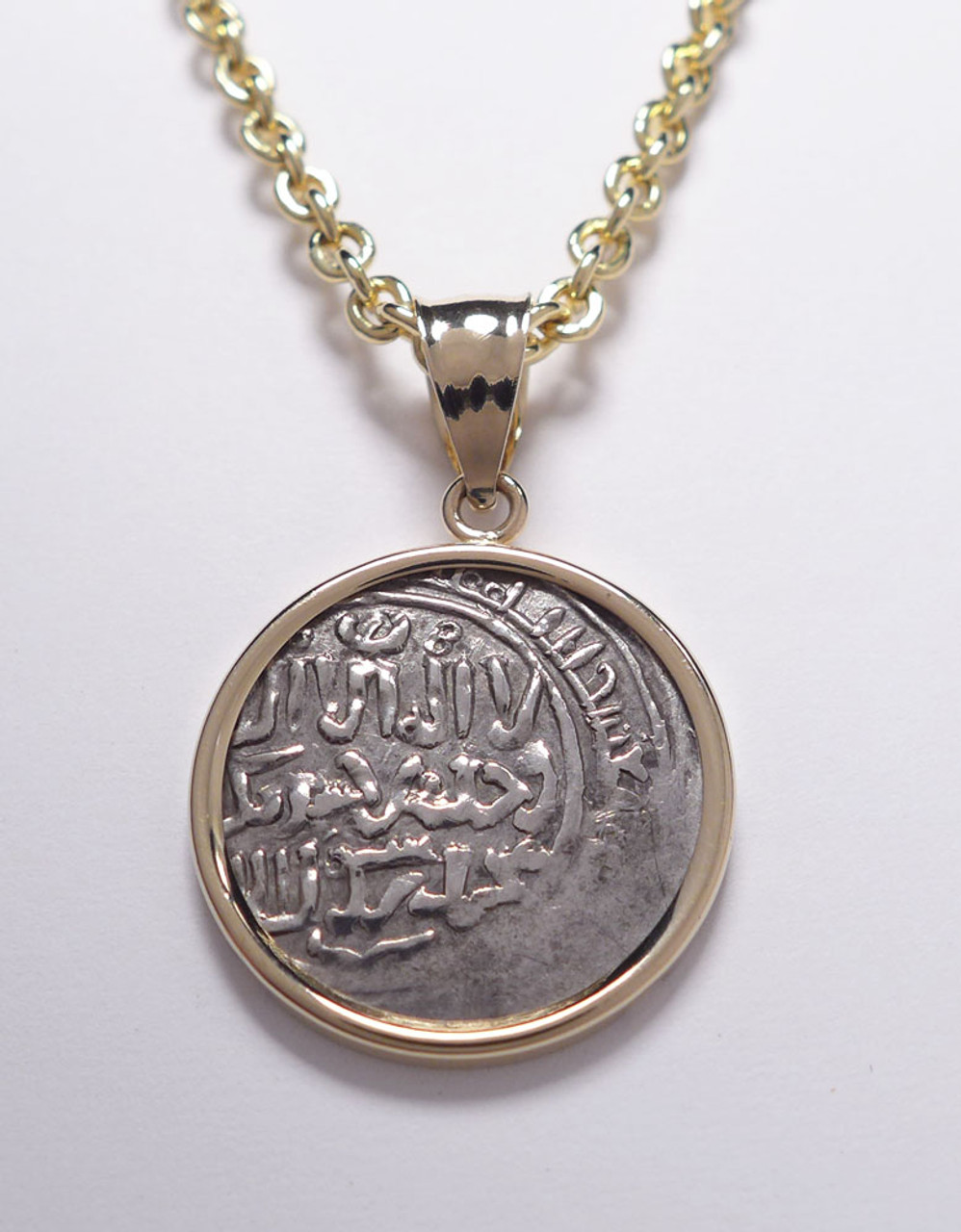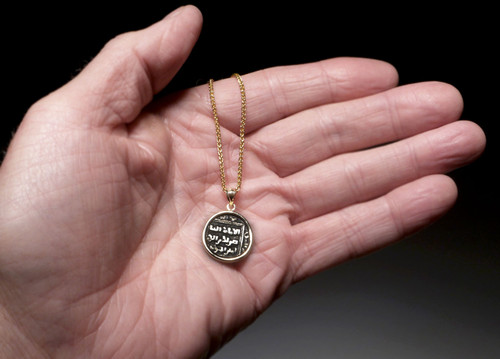Product Description
The Mamluks first appeared in the Abbasid caliphate in the ninth century AD. They rose to power and ruled Egypt and Syria from 1250 until 1517 AD when they were eventually defeated by the Ottoman Empire. During their reign, the Mamluks were responsible for the final destruction of the Crusader States. They also saved Syria, Egypt and the holy places of Islam from the Mongols. They made Cairo the dominant city of the Islamic world in the later Middle Ages. Their influence on the art and architecture of the Muslim world endured long after their decline.
This ancient Islamic Mamluk silver dirham coin was minted between 1250 - 1382 AD during the Bahri period. It is set in a high polished 14K yellow gold stamped smooth pendant setting in a unisex design making this pendant equally fitting for wear by either a man or woman. The coin features excellent detail and the tone of the ancient silver wonderfully contrasts with the bright gold of the pendant mounting.
*** Chain is not included but may be purchased additionally, at the link below
SETTING: 14KT YELLOW GOLD
COIN: SILVER DIRHAM
COIN AGE: 1250 - 1382 A.D.
DIMENSIONS: .80" or 20 mm overall diameter
:::: Includes Gift Box
:::: Includes CERTIFICATE OF AUTHENTICITY / HISTORY SHEET
ADD THE DISPLAYED THICK FORSANTINA GOLD CHAIN
MORE ANCIENT ISLAMIC COIN JEWELRY
HISTORY
HISTORY
The Mamluk Sultanate, also known as Mamluk Egypt or the Mamluk Empire, was a state that ruled Egypt, the Levant and the Hejaz (western Arabia) from the mid-13th to early 16th centuries. It was ruled by a military caste of mamluks headed by the sultan. The mamluk was an "owned slave", distinguished from the ghulam, or household slave. After thorough training in various fields such as martial arts, court etiquette and Islamic sciences, these slaves were freed however, they were still expected to remain loyal to their master and serve his household. Mamluks had formed a part of the state or military apparatus in Syria and Egypt since at least the 9th century, rising to become governing dynasties of Egypt and the Levant during the Tulunid and Ikhshidid periods. Mamluk regiments constituted the backbone of Egypt's military under Ayyubid rule in the late 12th and early 13th centuries, beginning with Sultan Saladin who replaced the Fatimids' black African infantry with mamluks. Most of the mamluks in the Ayyubids' service were ethnic Kipchak Turks from Central Asia, who, upon entering service, were converted to Sunni Islam and taught Arabic.
The Mamluk sultanate was established with the overthrow of the Ayyubid dynasty in Egypt in 1250, and was conquered by the Ottoman Empire in 1517. Mamluk history is generally divided into the Turkic or Bahri period (1250–1382), and the Circassian or Burji period (1382–1517), called after the predominant ethnicity or corps of the ruling Mamluks during these respective eras.
Mamluk decorative arts such as enameled and gilded glass, inlaid metalwork, woodwork, and textiles, were prized around the Mediterranean as well as in Europe, where they had a profound impact on European production. Trade with Iran, India, and China was even more extensive, turning Mamluk cities into centers of both trade and consumption.
Mamluk architecture is distinguished in part by the construction of multi-functional buildings whose floor plans became increasingly creative and complex due to the limited available space in the city and the desire to make monuments visually dominant in their urban surroundings. While Cairo was the main center of patronage, Mamluk architecture also appears in other cities of their realm such as Damascus, Jerusalem, Aleppo, and Medina. Patrons, including sultans and high-ranking emirs, typically set out to build mausoleums for themselves but attached to them various charitable structures such as madrasas, khanqahs, sabils, or mosques.
 US Dollars
US Dollars
 AUD
AUD
 CAD
CAD
 POUNDS STERLING
POUNDS STERLING
















